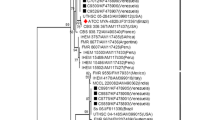Abstract
Sporotrichosis is usually a localized, lymphocutaneous disease, but its disseminated type was rarely reported. The main objective of this study was to identify specific DNA sequence variation and virulence of a strain of Sporothrix schenckii isolated from the lesion of disseminated cutaneous sporotrichosis. We confirmed this strain to be S. schenckii by® tubulin and chitin synthase gene sequence analysis in addition to the routine mycological and partial ITS and NTS sequencing. We found a 10-bp deletion in the ribosomal NTS region of this strain, in reference to the sequence of control strains isolated from fixed cutaneous sporotrichosis. After inoculated into immunosuppressed mice, this strain caused more extensive system involvement and showed stronger virulence than the control strain isolated from a fixed cutaneous sporotrichosis. Our study thus suggests that different clinical manifestation of sporotrichosis may be associated with variation in genotype and virulence of the strain, independent of effects due to the immune status of the host.





Similar content being viewed by others
References
Miyaji M. Defensive role of granuloma against Sporotrix sckenckii infection. Myopathologia. 1982;80:117–24.
Ishizak H, Kawasaki M, Aoki M. Mitochondrial DNA analysis of Sporotrix sckenckii in North and South America. Myopathologia. 1998;142:115–8.
Kong X, Xiao T, Lin J, et al. Relationships among genotypes, virulence and clinical forms of Sporothrix schenckii infection. Clin Microbiol Infect. 2006;12:1077–81.
Liu X, Lian C, Jin L, et al. Characterization of Sporothrix schenckii by random amplification of polymorphic DNA assay. Chin Med J. 2003;116:239–42.
Marimon R, Cano J, Gene J, et al. Sporothrix brasiliensis, S. globosa, and S. Mexicana, three new sporothrix species of clinical interest. J Clin Microbiol. 2007;45:3198–206.
Liu X, Lin X. A case of disseminated sporotrichosis. J Dermatol. 2001;28:95–9.
Graham GC, Mayers P, Henry RJ. A simplified method for the preparation of fungal genomic DNA for PCR and RAPD analysis. Biotechniques. 1994;16:48–50.
Liu D, Coloe S, Baird R, et al. Application of PCR to the identification of dermatophyte fungi. J Med Microbiol. 2000;49:493–7.
Hajjeh R, McDonnell S, Reef S. Outbreak of sporotrichosis among tree nursery workers. J Invent Dermatal. 1997;176:499–504.
Ishizaki H, Kawasaki M, Aoki M, et al. Mitochondrial DNA analysis of Sporotrix schenckii from China, Korea and Spain. Med Mycol. 2004;45:23–5.
Carlotti A, Chaib F, Couble A, et al. Rapid identification and fingerprinting of Candida krusei by PCR-based amplification of the species-specific repetitive polymorphic sequence CKRS-1. J Clin Microbiol. 1997;35:1337–43.
Bain JM, Tavanti A, Davidson AD, et al. Multilocus sequence typing of the pathogenic ungus Aspergillus fumigatus. J Clin Microbiol. 2007;45:1469–77.
Jackson CJ, Barton RC, Kelly SL, et al. Strains identification of Trichophyton ribrum by specific amplification of subrepeat elements in the ribosomal DNA nontranscribed spacer. J Clin Microbiol. 2000;38:4527–34.
Brito MM, Conceicao-Silva F, Morgado FN, et al. Comparison of virulence of different Sporothrix schenckii clinical isolates using experimental murine model. Med Mycol. 2007;45(8):721–9.
Uenotsuchi T, Takeuchi S, Matsuda T, et al. Differential induction of Th1-prone immunity by human dendritic cells activated with Sporothrix schenckii of cutaneous and visceral origins to determine their different virulence. Int Immunol. 2006;18(12):1637–46.
Acknowledgments
This study is funded by National Natural Science Foundation of China.
Conflict of Interest
None.
Author information
Authors and Affiliations
Corresponding author
Electronic supplementary material
Below is the link to the electronic supplementary material.
Rights and permissions
About this article
Cite this article
Zhang, Z., Liu, X., Lv, X. et al. Variation in Genotype and Higher Virulence of a Strain of Sporothrix schenckii Causing Disseminated Cutaneous Sporotrichosis. Mycopathologia 172, 439–446 (2011). https://doi.org/10.1007/s11046-011-9441-7
Received:
Accepted:
Published:
Issue Date:
DOI: https://doi.org/10.1007/s11046-011-9441-7




